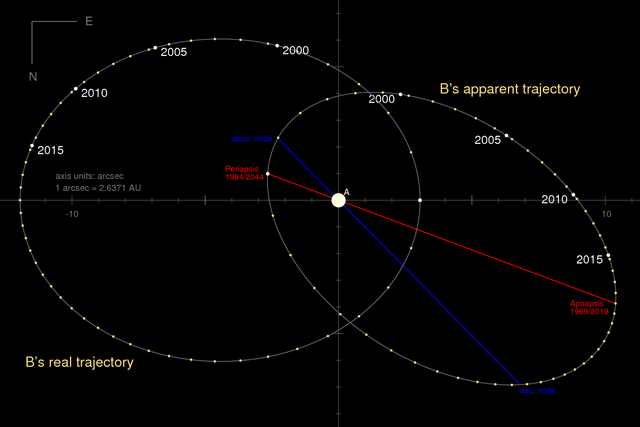 |
This is a file from the Wikimedia Commons. Information from its description page there is shown below.
Commons is a freely licensed media file repository. You can help.
|
Summary
| Description |
English: Trajectory of Sirius B relative to Sirius A as seen from Earth and as seen from above. The axis is scaled in arcseconds.The orbital parameters this plot is based on are taken from van den Bos (1960; used now in en.wikipedia:Sirius). The graph has been created with gnuplot based on data generated by solving Kepler's equation. Notes: 1. The time stamps refer to the motion as seen from Earth, i.e. delayed with respect to the true motion by the travel of light by about 8.7 years. North is down, as usual in many astronomical charts. 2. The points refer to steps of 1/50 of an orbit rather than to exact 1-year steps (which would be 1/50.09 of an orbit).
|
| Date |
8 August 2011 |
| Source |
Own work |
| Author |
SiriusB |
Licensing
I, the copyright holder of this work, hereby publish it under the following licenses:
 |
Permission is granted to copy, distribute and/or modify this document under the terms of the GNU Free Documentation License, Version 1.2 or any later version published by the Free Software Foundation; with no Invariant Sections, no Front-Cover Texts, and no Back-Cover Texts. A copy of the license is included in the section entitled GNU Free Documentation License. http://www.gnu.org/copyleft/fdl.htmlGFDLGNU Free Documentation Licensetruetrue
|
You may select the license of your choice.
|
File usage
The following pages on Schools Wikipedia link to this image (list may be incomplete):
Wikipedia for Schools brings Wikipedia into the classroom. Our 500 Children's Villages provide a home for thousands of vulnerable children. Beyond our Villages, we support communities, helping local people establish better schools and delivering effective medical care to vulnerable children. We have helped children in Africa for many years - you can help too...



